EU Considers Adding Crypto, BNPL in Payment Directive

The European Commission has launched a public consultation to gather information for its review of the second EU Payment Services Directive (PSD2). The Commission has published two papers on this issue, a questionnaire for the general public and one for industry experts.
The consultations started on May 10 and the deadlines for submissions are July 5 for the targeted consultation on technical matters and Aug. 2 for the general public. The general consultation is a simple questionnaire with basic questions about the success of the PSD2 for the last five years. Answers to these questions will hardly give the European Commission a sense of what worked or didn’t work with the PSD2. Essentially, the commission is asking for the method of payment used in physical stores and online, it also explained that the PSD2 introduced anti-fraud measures like the strong customer authentication (SCA) requirements, and the regulator takes the opportunity to request people´s opinion of new payment options offered by tech companies.
See also: EU Banking Authority Payment Fraud Consult May Impact PSD2
The targeted consultation, on the other hand, is addressed to the different players involved in the payment industry and it offers some interesting insights into what areas the regulator may be more interested in. The main objectives of the PSD2, which are also reflected in the questionnaire, are, according to the commission, to create a more integrated and efficient European payments market, and to open up this market to more competition. For instance, the PSD2 aims to facilitate new ways to pay, while ensuring a high level of security and consumer protection, in a technology and business model-neutral way that allows for the development of new types of payment services.
The commission starts by questioning the scope of the PSD2 and suggests changes in the definition of payment providers and other services in view of the payment methods now available that were not present 5 years ago.
In this regard, the commission mentioned in the report new methods of payments, including wallets, account-to-account, smartwatch and even stablecoins. Most significantly, the regulator asks if payment transactions using crypto assets (including stablecoins) and Buy Now Pay Later schemes should be included in the PSD2 list of services. And if so, what other changes would be necessary to the supervisory provisions. This is not to say that the regulator would include them in any potential revision, but it is noticeable that this is one of the first questions in the consultation.
Another area of interest for the regulator is the right to access credit institutions’ payment account services. The commission is requesting feedback on whether the European Banking Authority should mandate developing technical standards or guidance to ensure a consistent application of this right. The paper doesn´t elaborate further, but this could include standard application programming interfaces (APIs) that could facilitate wider adoption of open banking across Europe.
Open banking is another area that which the consultation devotes significant space in the paper. But rather than starting with questions about expanding open banking, the first questions seek when access to accounts can be limited and whether access to data should continue being free. Compensation to data holders for sharing data has also been suggested in the Open Finance consultation and in the EU Data Act.
The last area of interest in the consultation is the need to update PSD2 to prevent fraud and protect users. This could include changes in the SCA requirements, for instance with respect to the value of those payments that can be made contactless without a two-step authentication.
Read More: EU Regulator Launches PSD3, Open Finance Consultations
